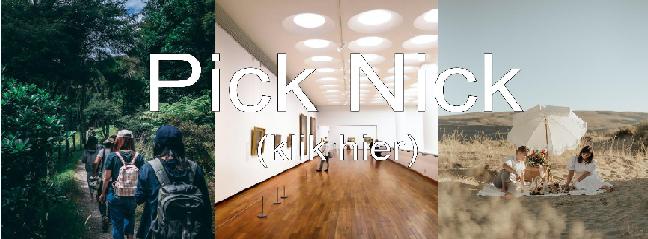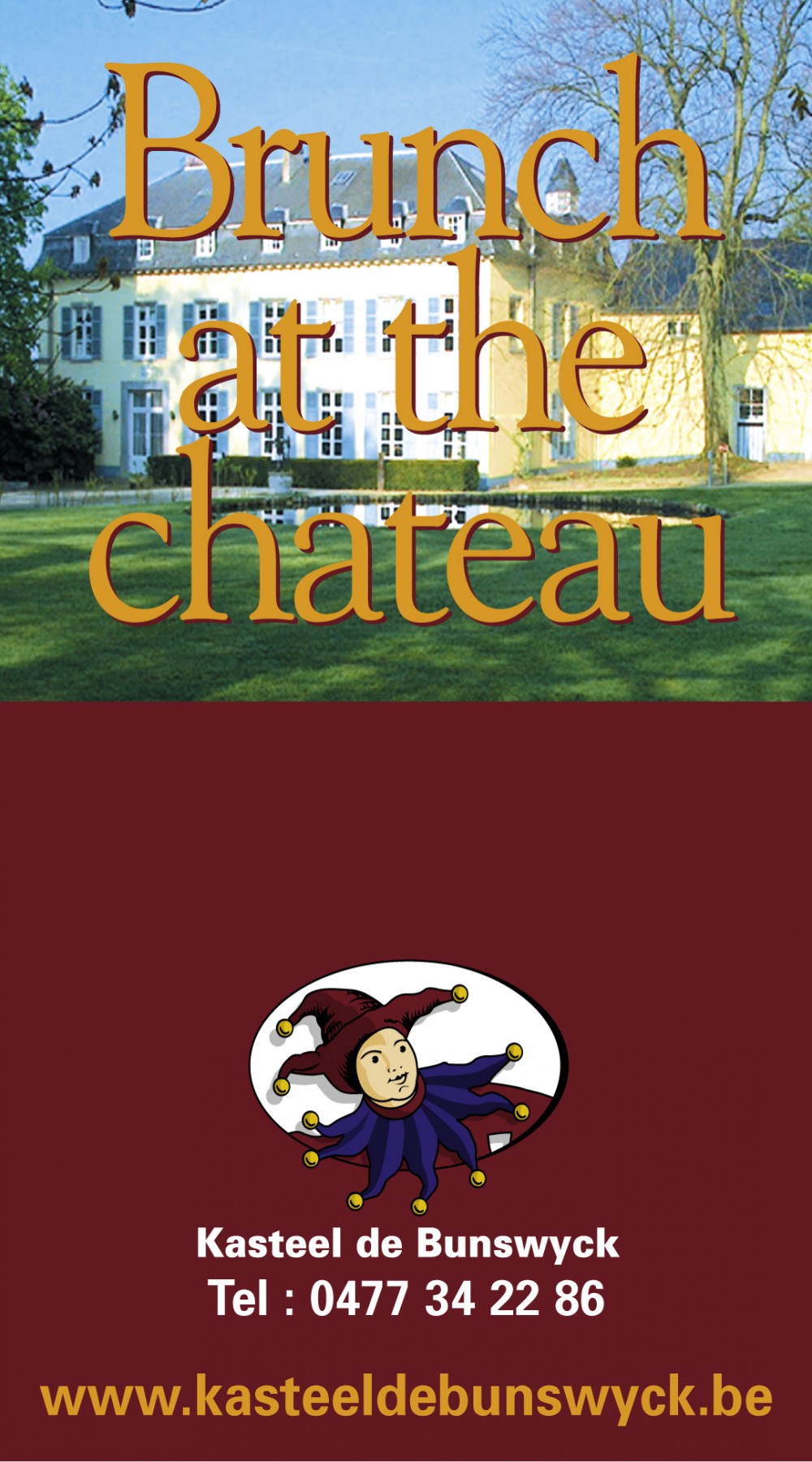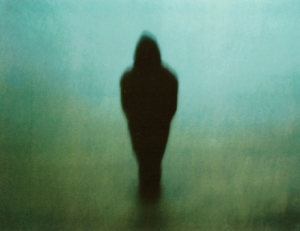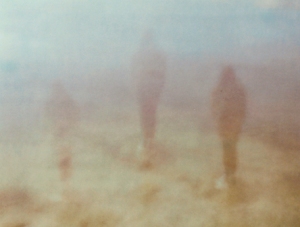From Spanish Chapels to First Born is a series of photographs that were taken during the artists’ road trip through Spain, inspired by the historical pilgrimage taken by couples since medieval times that walked the Way of Saint James in hopes of bearing children. These are digitally abstracted images of places visited such as Spanish monasteries, churches, and cathedrals, as well as celebrations and events that took place during the journey to have a child.
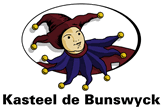 |
|
|
|
|
Artist in residence Kasteel de Bunswyck in Leuven
Alle getoonde werken zijn te koop. Contacteer Kasteel de Bunswyck of Katleen Sterck (0477/605.869) voor meer info.
Katleen Sterck, originally from
Sterck and Rozo paint with a camera. Their work breaks the bounds of traditional photography. It reveals the unseen, that what lies hidden, the in-between, what’s suspected but not named, the ghosts of things. The entities hidden in nature, brought to the surface by rearranging reality, showing the world to you in a different way.

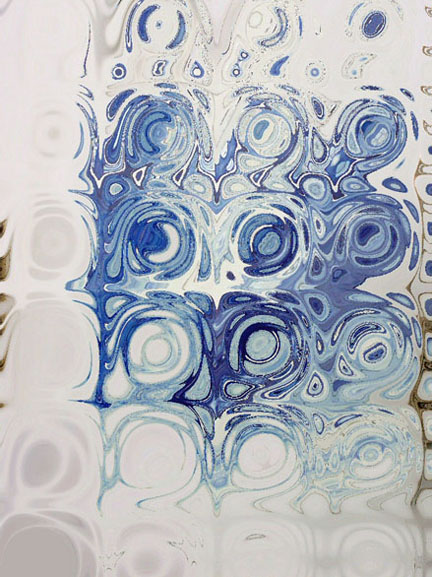
Portraits, Snowflakes and Chandeliers 19, 48 x 48? Lambda print
zzxxx
Portraits, Snowflakes and Chandeliers was created by mirroring or double-mirroring a sharp, vibrant image of trees, water or some other organic form. By mirroring a fragment of nature, we made visible the entities, the portals and the energies hidden under the chaos of random life. We organized the chaos and revealed what we feel but can never see. The work portrays fairies, hobbits and goblins, animals and mythological figures, and exposes the doorways to the world they inhabit.
The perfect symmetry and the wealth of detail give the work a Zen-like character that draws you in and puts you in a meditative state much like a Mandela. According to the viewing distance, different faces and symbols are exposed or concealed. The light coming from all directions at once and the different perspective give the work a three-dimensional quality. The result is disengaging because it questions the viewer’s intuitive knowledge of time and space.
Looking at photos of Indians by William S.Curtis and at National Geographic photos of warriors from the island of Nias, we noticed the similarities in imagery used in the masks and totems made by indigenous peoples, and the masks and faces that appear in our work. It seemed like they could see the very same things that we capture. They looked at trees, rocks, sand – all the things that have not changed – and completed the image, closed the circle and mirrored the faces to make visible the spirits they believed in. The story that says that Native Americans designed their totem poles and masks by laying down on their side next to a pond and gazing at the reflection of the trees in the still water, might explain the resemblance.
xx
xx
xx
zzz
zzzz
zzzz
zzzz
zzzz
x
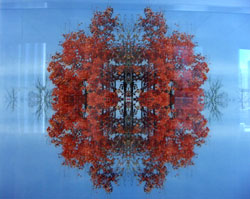
Solve et Coagula II #8, 30 x 30? C-Print
zz
Solve et Coagula is a term that was used in alchemy. It is Latin for “dissolve and combine”. The alchemists believed that all matter came from the same source and that dissolving, combining, and purifying of the base substances could produce gold. We took this idea and applied it to this particular series.
Our earlier color bodies of work, The Darker Stage of Twilight, From the Velvet Underground, and Energy/Matter, had all been photographed with an old Polaroid Land Camera, straight out of the 60’s. Actually, we were not sure of its origin, but one day we took the lens off, taped a piece of aluminum foil pierced with a sewing needle, and, “voila”, it was now a pinhole camera. In the cold and desolation of winter, we’d walk the dunes of Provincetown, or the back marshes and underbrush of Truro, and made images that were hand held, with long exposures. We experimented with the development times and temperatures of the Polaroid film, sometimes causing rivulets of dye to form; the results were painterly.
For Solve et Coagula we used the same Polaroid camera, only this time our interest was held in the paper “negative”, (base substance), that is peeled from the print and thrown out. Loaded with empty photo paper boxes, we would shoot an image, peel the negative, and carefully tape it in a box for its protection. The chemicals that remained on the paper would then start to crystallize and go off into incredible configurations. We would check the “negative”, for a few days or weeks until we felt that it was ready, re-shoot it with a medium format camera, and enlarge it using the color negative and a traditional enlarger.
We chose Fujiflex paper because it gave the images an incandescent quality not obtainable with other papers. And in the end what was once looked upon as something to be discarded, became an object purified, beautiful and inspiring. Gold for the soul.
xx
Solve et Coagula II #2, 30 x 40? C-Print
Gabriel/Strength of God, 30 x 40? C-Print
zzz
Energy/Matter was influenced by a movement among scientists and mathematicians concerning the existence of God. They pose the question: can science reach beyond physical reality and prove that a divine being or force oversees the universe?
In Tulane University’s mathematician, Frank Tippler’s book, “The Physics Of Immortality”, the proof of the existence of God lies in his “Omega Point Theory”. According to this theory, the entire cosmos will eventually be united in the mathematical equivalent of the sum of all points in time and space. Essentially, at the end of history, billions of years from now, “ life will evolve to its ultimate future – the Omega Point (God), the point of infinite knowledge (omniscience) and occupation and control of the universe ( omnipresence and omnipotence). Nothing more can happen.
xxxxxxxxxx
The Here and Now, 60 x 40? C-Prints, diptych
The figure in The Here and Now is in front of a cosmic hour glass with the sand on top representing the future and the sand on the bottom the past. The middle is the here and now.
zz
Three Figures 8, 30 x 40? C-Print
The recurring theme of the cycles of life is expressed in a rather organic way in the series Creation. This group consists of six works. Out of, what looks like, earth and water a figure is molded. In one piece the figure looks more like a genie that just came out of a bottle. Another one suggests a figure rising from the mist. The dark green monochromatic shades evoke the depths of the ocean. A combination of alchemical and photographic processes is used. But above all the main element is time.
ZZZ
Creation 1, 30 x 40? C-Print
xxxxxx
Creation 1, 30 x 40? C-Print
A motorcycle accident in New York City changed the course of our collaboration. The work started to reflect the questions that come up when one is faced with ones mortality. Our work evolved from autobiographical portraits to the study of the figure. The figure being a universal representation of the soul in relation with the Force (Cosmic). We found that by using each other as the figure we could make an image both universal and intimate.
zzz
Of Time and Space I # 4, 30 x 40? C-Print
zz
Of Time and Space I # 8, 30 x 40? C-Print
The Darker Stage of Twilight 7, 40 x 90? C-Prints, triptych
| Copyright © Kasteel de Bunswyck. All rights reserved. -- last update 25 augustus 2021 This website was powered by Ewisoft Website Builder. |
